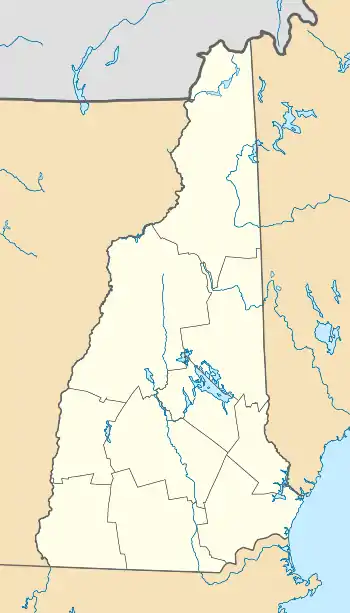Waterloo Historic District | |
 | |
  | |
| Location | 78-183 Waterloo St., 12 and 68 Newmarket Rd., 4 Willoughby-Colby Rd., Bean Road Cemetery, Warner, New Hampshire |
|---|---|
| Coordinates | 43°17′19″N 71°51′15″W / 43.28861°N 71.85417°W |
| Area | 50 acres (20 ha) |
| Built | 1791 |
| Architectural style | Georgian, Federal |
| NRHP reference No. | 03000926[1] |
| Added to NRHP | September 13, 2003 |
The Waterloo Historic District encompasses the site of one of the first mills on the Warner River, near the Waterloo Falls in Warner, New Hampshire. The 50-acre (20 ha) district includes most of the original 60-acre (24 ha) land grant for the mill site. It extends along Waterloo Street and Newmarket Street for a length of about 1 mile (1.6 km), from where Newmarket Street crosses the Warner River to where Waterloo Street crosses a brook. In addition to its industrial history, the district is notable for being home to two nationally known politicians: William E. Chandler (1835-1917), who served as United States Senator and as United States Secretary of the Navy, and Nehemiah G. Ordway (1828-1907), the seventh governor of the Dakota Territory.[2]
This part of Warner was first sold off for development in the 1770s, and the first sawmill was operating by 1789. The oldest surviving house in the district, a 1+1⁄2-story Cape style house, was built in 1791, and a significant number of houses in the district were built before 1820. William Chandler's house, purchased by him in 1872, was built in 1805, and he purchased a nearby 1820s house for staff he needed for entertaining high-profile guests. Nehemiah Ordway's house, at the corner of Newmarket and Waterloo, was built in 1828, but was restyled in the early 20th century to give it a Colonial Revival appearance.[2]
Several non-residential buildings have survived, although most have been repurposed into residences. The Bean Tavern is a Georgian structure built in 1793. Two structures that served as train stations survive, one built in 1849, which was moved a short distance to make way for the second, built in 1910. The principal surviving industrial building is the 1836 Chandler Mill, whose surviving 2+1⁄2-story portion stands off Newmarket Street between the railroad tracks and the river. Remnants of earlier mill foundations lie nearby. The district also includes a cemetery (1815), and a c. 1810 one-room schoolhouse.[2]
The district was listed on the National Register of Historic Places in 2003.[1] It also includes the Waterloo Covered Bridge, a separately-listed bridge which carries Newmarket Street over the river.[2]
See also
References
- 1 2 "National Register Information System". National Register of Historic Places. National Park Service. March 13, 2009.
- 1 2 3 4 "NRHP nomination for Waterloo Historic District". National Park Service. Retrieved March 15, 2014.
